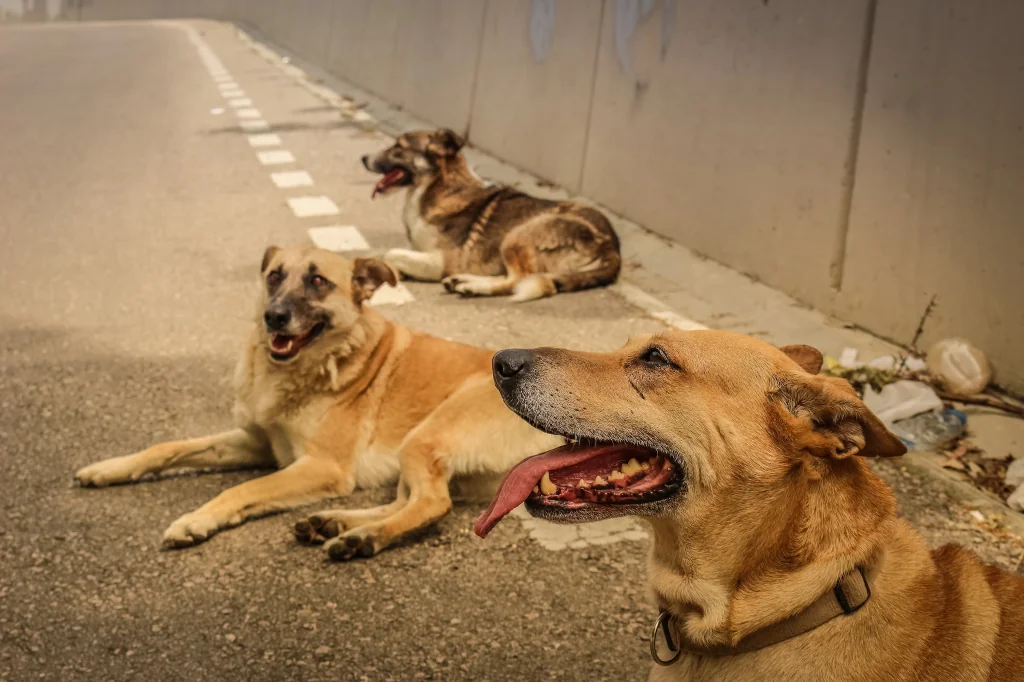Stray dog packs – a puzzling sight and a dilemma for many city dwellers, stirring concerns about safety, dog welfare, and their impact on our urban ecosystem. While some people think they know this, they still often ask: Why do stray dogs typically form packs?
The dynamics within these packs and how they go about their daily life is a compelling story of resilience, survival, and instinctual intelligence.

Why Do Dogs Naturally Form Packs?
Pack formation is rooted in a dog’s DNA, tracing back to their wild ancestors – the wolves.
Wolves are renowned for their structured, highly-organized pack life that ensures their survival in the wild. When dogs went astray, they instinctively replicated this behavior.
Forming packs offers protection, improves hunting efficiency, and provides a sense of belonging. It’s essentially a social survival mechanism – the street-savvy version of “strength in numbers.”
In each pack, there’s usually a pecking order, much like in a wolf pack. This hierarchy reduces conflict and fosters cooperation, ensuring smoother functioning and survival of the pack. It’s a fascinating spectacle of animal behavior that’s both instinctive and learned.
How Do Stray Dog Packs Typically Spend Their Day?
Stray dogs lead a life orchestrated by basic needs – food, safety, and rest.
Mornings often start with foraging. They sniff out leftovers, rubbish bins, or frequent areas where generous humans might offer a meal. Unlike their domestic counterparts, meals aren’t a guaranteed luxury, so the search for food occupies a significant portion of their day.
After satisfying their hunger, they might play or interact, strengthening social bonds within the pack. These interactions also help to reinforce the pack’s hierarchy.
As day turns to night, securing a safe place to sleep becomes paramount. They often huddle together in abandoned buildings, quiet alleyways, or under vehicles, using the safety of their pack to deter potential threats.
While some sleep, others stay alert, keeping a watchful eye on their surroundings. This way, they manage to endure another day, driven by instinct and the companionship of their pack.
How Do Stray Dogs Create Their Packs? (size and hierarchy)
Pack formation among stray dogs is an intriguing process, governed by instincts, survival needs, and social dynamics.
It’s not as simple as a group of dogs deciding to hang out together. Instead, it’s an organic process influenced by a multitude of factors.
Stray dogs typically form packs based on their social interactions and relationships. Some dogs might form bonds after encountering each other at feeding spots or while wandering the same streets. Over time, mutual trust develops, leading to the formation of a pack.
Dog packs can form around a dog that demonstrates strength or confidence, drawing in others with its sense of direction. However, leadership in these groups is fluid and situational, not fixed. While one dog may lead in some situations, others can step up based on their unique skills, experiences, or age. This reflects the complex and varied nature of pack dynamics.
Pack size can vary greatly, depending on the availability of resources like food and shelter. It’s common to find smaller packs of 3-5 dogs in resource-poor areas, while larger packs of up to 15 dogs might be observed where resources are abundant.
Within these packs, a hierarchy usually emerges, typically based on the dogs’ age, strength, and personality. The pack leader, often the most assertive and experienced dog, commands the respect of the pack. Other members fall into a pecking order below the leader, with each dog knowing its place in the pack, reducing conflicts and ensuring the group’s smooth functioning.
Are Stray Dog Packs Dangerous to People or Pets?
While most stray dogs are not inherently aggressive or dangerous, the dynamics can change when they are part of a pack. Their behavior is dictated by their survival instincts and the need to protect their pack and territory.
If a stray dog pack perceives humans or pets as a threat, they might respond defensively, which can be dangerous. Dogs, like any animals when threatened, can resort to aggression to protect themselves.
This is why it’s essential never to corner a stray dog or make sudden movements that could be interpreted as hostile.
However, this doesn’t mean that all stray dog packs are a menace. Many coexist peacefully in human-dominated landscapes, avoiding confrontation as much as possible, unlike feral dogs who may sometimes show aggression and bark.
Remember, most stray dogs are just trying to survive in a challenging environment. They are more likely to be scared of you than you are of them. However, it’s best not to approach a pack of stray dogs, as it’s potentially dangerous, plus they carry certain risks.
Risks and Challenges With Stray Dog Packs
- Public Safety. A pack’s defensive behavior could be a risk, especially if humans or pets encroach on their perceived territory.
- Health Risks. Stray dogs can carry diseases such as rabies or parasites, which pose health risks to both humans and pets. These can potentially be transmitted to humans or pets, highlighting the need for proper health management in dog populations.
- Impact on Wildlife. In areas rich in biodiversity, stray dog packs can disrupt ecosystems by hunting native species or outcompeting them for resources. Their impact extends beyond immediate interactions, potentially upsetting delicate ecological balances.
A less-recognized challenge is the emotional stress for the dogs themselves. Life as a stray can be tough, with constant threats from traffic, starvation, and extreme weather conditions. Often overlooked, their emotional wellbeing is a significant part of the equation that needs attention.
How to Deal With a Pack of Stray Dogs?
Interacting safely with a stray dog pack requires a nuanced understanding of their behavior. Here are some useful pointers:
- Stay Calm. If you encounter a stray dog pack, don’t panic. Avoid direct eye contact and move away slowly without turning your back on them.
- Distraction. A unique but effective trick – if pursued, throwing a handful of gravel or even dry leaves toward the dogs but not directly at them can confuse the dogs and buy you time to retreat. It’s non-harmful and exploits their curiosity.
- Professional Help. If a pack is causing trouble, alert your local animal control or animal welfare organization. They are equipped to handle such situations humanely.
Consider fostering a community initiative to aid these strays. You could reach out and collaborate with local animal welfare organizations, veterinary clinics, and volunteers to implement programs for neutering, vaccination, and rehoming of these dogs. Such proactive actions can alleviate the challenges associated with stray dog packs and transform them into a community asset rather than a liability.
Could You Adopt a Stray Dog Successfully?
Absolutely you could adopt a stray dog, but it’s not as easy as simply approaching the stray dog pack and taking one of them.
Adopting a stray dog can be a rewarding experience. However, it’s not without its challenges. You’ll need patience and understanding as your new friend learns to trust and adapt to a home environment. Here’s a potential roadmap:
- Health Check. Ensure the dog receives a thorough health examination. Vaccinations, deworming, and neutering/spaying should be done as necessary. Please consult our guide on the benefits and risks of neutering a dog.
- Behavioral Assessment. Consult with a professional to understand the dog’s behavior and temperament. This will help prepare for any behavioral adjustments. Your local animal welfare organization, a veterinarian, or a certified animal behaviorist can either provide the service or refer you to a trusted professional in your area.
- Gradual Integration. Ease the dog into their new surroundings gradually. Allow the dog to familiarize themselves with your home at their own pace.
- Training. Basic obedience training is essential in forming a bond and establishing good behavior. Start with teaching the dog their name, and how to sit, stay, and come to you.
- Patience. Remember, it may take time for the dog to adjust and trust. Be patient and persistent.
Adopting a stray isn’t just about providing a home. It’s about giving a second chance to a deserving soul while enriching your life in ways you never imagined. There are still many stray dogs in the US looking for a loving home.
FAQs
Are there wild dog packs in urban areas?
Urban environments can indeed harbor packs of stray dogs. They typically form in areas with ample food sources, like dumpsters or areas with substantial human activity.
Do domestic dogs have the tendency to join stray packs?
While uncommon, a domestic dog, particularly if lost or abandoned, may join a stray pack for companionship and survival.
How do dogs decide who leads the pack?
Dog packs typically have fluid leadership, with roles shifting based on various factors like age, experience, and specific skills relevant to different situations. Dog pack dynamics are complex, and often influenced by cooperative behaviors. Leadership is often shared.
Can a stray dog join a pack of wild dogs?
Generally, wild dogs are less accepting of dogs outside their pack. A stray dog may face challenges integrating into a wild dog pack due to significant differences in behavior and survival tactics.
Alex, a passionate animal lover, has experience in training and understanding animal behavior. As a proud pet parent to two dogs and three cats, he founded AnimalReport.net to share insights from animal experts and expand his knowledge of the animal kingdom.





Can dogs exhibit criminal behavior and, if so, how can owners address and correct it through training?
Dogs cannot exhibit “criminal behavior” as humans do, but they may display undesirable actions stemming from instincts or lack of training. These behaviors can be addressed through consistent positive reinforcement and professional guidance if needed.